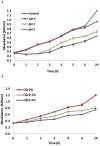Production and Characterization of Exopolysaccharide From Newly Isolated Marine Probiotic Lactiplantibacillus plantarum EI6 With in vitro Wound Healing Activity
- PMID: 35668753
- PMCID: PMC9164304
- DOI: 10.3389/fmicb.2022.903363
Production and Characterization of Exopolysaccharide From Newly Isolated Marine Probiotic Lactiplantibacillus plantarum EI6 With in vitro Wound Healing Activity
Abstract
Because of its safety, biological activities, and unique properties, exopolysaccharide (EPS) from lactic acid bacteria (LAB) has been developed as a potential biopolymer. A few studies have investigated the EPS produced by marine LAB. This study reports the wound healing activity of an EPS produced by a marine isolate identified as Lactiplantibacillus plantarum EI6, in addition to assessing L. plantarum EI6's probiotic properties. EI6 demonstrated promising antimicrobial activity against different pathogenic bacteria, as well as the ability to withstand stomach pH 3, tolerate 0.3% bile salt concentration, and exhibit no signs of hemolysis. Furthermore, EI6 was able to produce 270 mg/L of EPS upon growth for 48 h at 37°C in an MRS medium enriched with 1.0% of sucrose. The chemical features of the novel EI6-EPS were investigated: the UV-vis estimated a high carbohydrate content of ~91.5%, and the FTIR emphasized its polysaccharide nature by the characteristic hydroxyl, amide I, II, & III, and glycosidic linkage regions. The GC-MS and NMR analyses revealed the existence of five monosaccharides, namely, rhamnose, galactose, mannose, glucose, and arabinose, existing mainly in the pyranose form and linked together by α- and β-glycosidic linkages. EI6-EPS was found to be safe (IC50 > 100 μg/ml) and induced human skin fibroblasts (HSF) proliferation and migration. These findings imply that EI6 can be used as a safe source of bioactive polymer in wound care.
Keywords: Lactiplantibacillus; chemical characterization; exopolysaccharide; probiotics; wound healing.
Copyright © 2022 Zaghloul and Ibrahim.
Conflict of interest statement
The authors declare that the research was conducted in the absence of any commercial or financial relationships that could be construed as a potential conflict of interest.
Figures





Similar articles
-
Exopolysaccharide produced by Lactiplantibacillus plantarum RO30 isolated from Romi cheese: characterization, antioxidant and burn healing activity.World J Microbiol Biotechnol. 2022 Oct 26;38(12):245. doi: 10.1007/s11274-022-03439-6. World J Microbiol Biotechnol. 2022. PMID: 36287274 Free PMC article.
-
In vitro assessment of biofunctional properties of Lactiplantibacillus plantarum strain Jb21-11 and the characterization of its exopolysaccharide.Int Microbiol. 2024 Feb;27(1):239-256. doi: 10.1007/s10123-023-00387-5. Epub 2023 Jun 7. Int Microbiol. 2024. PMID: 37286917
-
Characterization of Lactic Acid Bacterium Exopolysaccharide, Biological, and Nutritional Evaluation of Probiotic Formulated Fermented Coconut Beverage.Int J Food Sci. 2024 Sep 2;2024:8923217. doi: 10.1155/2024/8923217. eCollection 2024. Int J Food Sci. 2024. PMID: 39257841 Free PMC article. Review.
-
Preparation of Novel Marine Enterococcus faecium MSD8 Exopolysaccharide Ointment and In Vivo Evaluation of Its Impact on Cutaneous Wound Healing in Male Albino Rats.Probiotics Antimicrob Proteins. 2025 Jun;17(3):963-975. doi: 10.1007/s12602-024-10334-z. Epub 2024 Aug 12. Probiotics Antimicrob Proteins. 2025. PMID: 39133428 Free PMC article.
-
A novel approach to Lactiplantibacillus plantarum: From probiotic properties to the omics insights.Microbiol Res. 2023 Mar;268:127289. doi: 10.1016/j.micres.2022.127289. Epub 2022 Dec 22. Microbiol Res. 2023. PMID: 36571922 Review.
Cited by
-
Microbial exopolysaccharides in the biomedical and pharmaceutical industries.Heliyon. 2023 Aug 1;9(8):e18613. doi: 10.1016/j.heliyon.2023.e18613. eCollection 2023 Aug. Heliyon. 2023. PMID: 37593641 Free PMC article.
-
Optimizing Exopolysaccharide Production by Bacillus subtilis Using Spoiled Fig and Grape.Curr Microbiol. 2024 Oct 15;81(12):408. doi: 10.1007/s00284-024-03913-4. Curr Microbiol. 2024. PMID: 39406962
-
Exopolysaccharide produced by Lactiplantibacillus plantarum RO30 isolated from Romi cheese: characterization, antioxidant and burn healing activity.World J Microbiol Biotechnol. 2022 Oct 26;38(12):245. doi: 10.1007/s11274-022-03439-6. World J Microbiol Biotechnol. 2022. PMID: 36287274 Free PMC article.
-
Exopolysaccharide produced from Lactiplantibacillus plantarum HAN99 and its nanoparticle formulations in agricultural applications.Sci Rep. 2025 Jun 1;15(1):19188. doi: 10.1038/s41598-025-03913-9. Sci Rep. 2025. PMID: 40451901 Free PMC article.
-
Comprehensive evaluation of bioactive properties and metabolomic profiling of probiotic bacteria Lactococcus lactis (MKL8).Sci Rep. 2025 Jul 1;15(1):21430. doi: 10.1038/s41598-025-02327-x. Sci Rep. 2025. PMID: 40595855 Free PMC article.
References
-
- Abdelhamid S. A., Mohamed S. S., Selim M. S. (2020). Medical application of exopolymers produced by marine bacteria. Bull. Natl. Res. Centre 44, 1–14. 10.1186/s42269-020-00323-x - DOI
-
- Adesulu-Dahunsi A. T., Jeyaram K., Sanni A. I. (2018). Probiotic and technological properties of exopolysaccharide producing lactic acid bacteria isolated from cereal-based nigerian fermented food products. Food Control 92, 225–231.
-
- Ahmed Z., Wang Y., Anjum N., Ahmad A., Khan S. T. (2013). Characterization of exopolysaccharide produced by Lactobacillus kefiranofaciens ZW3 isolated from Tibet kefir – Part II. Food Hydrocoll. 30, 343–350. 10.1016/j.foodhyd.2012.06.009 - DOI
LinkOut - more resources
Full Text Sources
Molecular Biology Databases
Miscellaneous

